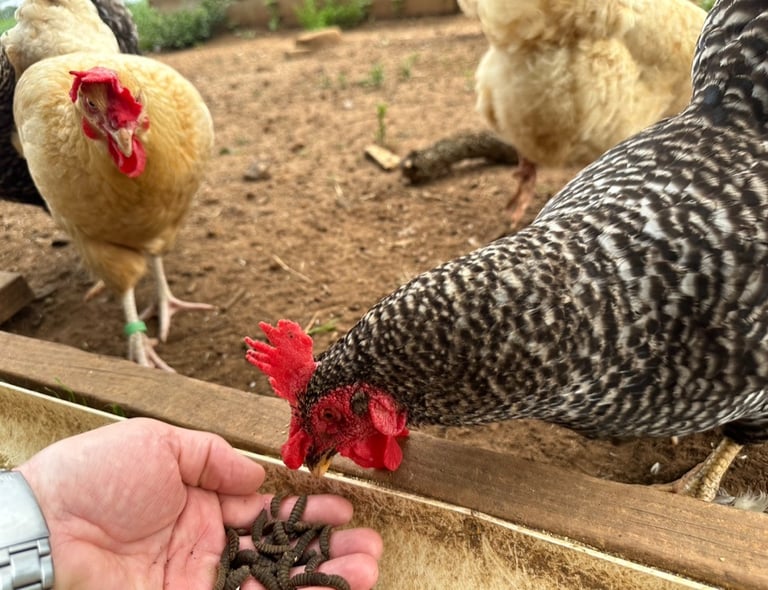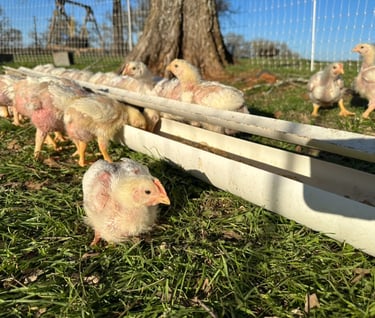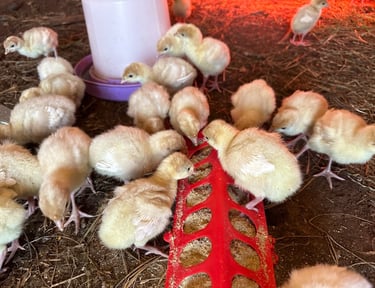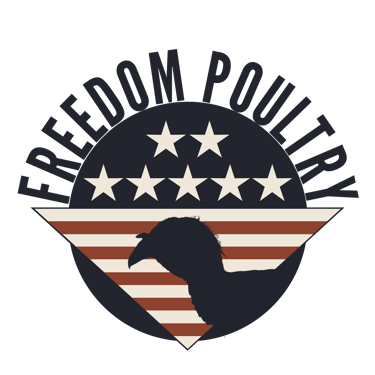Nutritional Requirements for Pastured Poultry
What nutritional requirements do pastured poultry have?
CHICKENSTURKEYSFEED


Nutritional Requirements for Pastured Poultry:
A Comprehensive Guide For Feed, Forage, and Vitamins
As pastured poultry gains popularity in our society, one of the biggest concerns to address is the nutritional requirements of pastured birds. Consumers are looking for healthier and more ethically raised meat options and if the animals are not fed well, then both nutrition and animal welfare are diminished. One of the big benefits of pasture raised poultry is that they get to engage in natural behaviors - foraging for insects and plants, scratching and pecking the ground, taking dust baths, but we must make sure that they are getting all of the essential nutrients that promote overall health. To ensure optimal growth, health, and productivity, we must understand the specific nutritional requirements poultry has - and meet those needs.
My goal in this post is to delve into the essential nutrients needed by pastured poultry, explore their roles in chicken and turkey health, and discuss practical strategies that we have employed to meet these requirements.
Protein Requirements:
Protein is a fundamental necessity not just for poultry, but for all animal life. For our context of poultry, protein plays a critical role in body development, muscle growth, and feather production. Pastured poultry require adequate levels of dietary protein to support their developing bodies. If these needs are ignored, you may face disastrous outcomes - like the time I thought I could just feed my turkey chicks regular chick starter... it resulted in the loss of almost all of them.
Protein Levels in Feed for Different Growth Stages:
When we think about protein, we must consider a few things - Age, species, and bird purpose (meat or eggs). I will include the generally acceptable protein levels for poultry below. As a side note - although these are generally recommended protein levels, we don't always stay within those limits, but it is always erring on the side of abundance rather than lack. Better to feed them more protein than necessary than too little.
Chickens:
Chicks (0-6 weeks): Recommended protein levels range from 18% to 22%. This is consistent whether you are speaking about chicks that will be egg layers versus chicks that are being raised for meat. While the recommended range is 18-22%, at Freedom Poultry, we utilize a 21% crude protein feed. I like the higher protein levels for our chicks, because I feel like it gives them the extra kick that they need in development of bone structure, muscle, and feathers.
Growers (6-16 weeks): Protein levels should be around 16% to 18%. This is true whether you are talking about hens that will become layers AND meat birds. In regards to meat birds, most commercial chicken farmers would not think about allowing their chickens to reach 16-weeks old. Most of them are slaughtering their birds around 8-weeks. The exception to this is if you are raising a slower growing meat bird other than a Cornish Cross, commonly called a broiler. If you are raising Freedom Rangers or another variety like this, you may reach 16 weeks. At Freedom Poultry, we raise Cornish Crosses and we slaughter at 8-9 weeks old. We also depart from the "acceptable" range... We use a 19% crude protein feed for our broilers. Broilers need more protein than layers because they are constantly putting on weight until time for slaughter. I have even continued our 21% starter feed all the way through to slaughter because we had so much on hand. For layers, the higher protein levels are still needed as they continue to grow and prepare to lay eggs. Again, we have continued to use starter feed (21% protein) all the way through 16 weeks. The only drawback that I have found is a slight cost
Layers (16+ weeks): Protein levels of 16% are sufficient for laying hens. Once the layers reach laying age, their overall protein intake can be reduced. Your run-of-the-mill layer feed is going to be 16% almost as a rule. If you are buying from a more boutique feed mill, you may have something a bit higher than 16%. At Freedom Poultry, we utilize a 17% crude protein layer feed.
Turkeys:
I mentioned this in the introduction to the protein section, but turkeys have different nutritional needs than chickens do. This is also true for other game birds like pheasants, guinea fowl, pea fowl, etc. Part of this is that these birds are "less domesticated" than chickens. Higher protein feeds are crafted to mimic their diet in nature as closely as possible. The metabolism in these "game birds" is generally tuned to conserve energy, because in the wild, they do not have a friendly farmer who puts feed out every day. They need to be able to go longer between meals.
Chicks (0-6 weeks): Recommended levels should be around 26% to 28%. There is a quick point to note here. It is supremely difficult to find feed with these protein levels at commercial feed stores like Tractor Supply - and I wouldn't recommend you buy from them anyhow. You will likely need to find a local mill that can custom formulate a turkey feed for you, or find one that will ship to you. We purchase 26% crude protein feed in 2000lb totes and have it shipped to our farm.
Growers (7 weeks - market): Recommended levels should be around 19% to 26%. Like our chickens, at Freedom Poultry, we will sometimes continue to feed our birds the starter feed throughout the duration of their lives. The extra protein has not been a problem and it keeps us from letting feed go to waste. If we switch over to a grower feed, we use a 23% crude protein feed. So, for the duration of their lives, our turkeys get more protein than our chickens will get at any point in their lives.
Other Protein Sources for Pastured Poultry:
Pastured poultry are unique in that they are able to find additional food sources by foraging for plants and insects. Because of the nature of this lifestyle, it is impossible to quantify exactly how much protein they are consuming when on pasture. One example of an insect that poultry may find on pasture is a cricket. Crickets are roughly 65% protein, so they serve as an incredible food source for poultry. Unfortunately, it is impossible to quantify what percentage insects are of the birds' diet.
Another source of protein that we have employed at Freedom Poultry is soldier fly larvae. With a simple setup (you can see ours on YouTube), we are able to produce a reliable and sustainable protein source for our birds. Throughout the majority of the spring and summer months, we will simply place our kitchen scraps into a large storage bin and let the Lord do His work. Soldier flies show up, lay their eggs, and presto, we have chicken feed. Soldier fly larvae are great, because they are easy to farm and are an excellent protein source. They are also packed with a host of other minerals and vitamins - which if you are interested in knowing more, here is a great scientific article.
Another source of protein that poultry on pasture will consume comes from plant proteins. This is another hard one to quantify, unless you know the exact plants that you have represented and have done nutritional testing. While we have not done any such testing on our pastures, we do know that there are plants that are contributing to the protein intake of our birds. This past season, we planted cowpeas, brown top millet, sorghum, and buckwheat.
Carbohydrate Requirements:
One of the other essential dietary needs that poultry have are carbohydrates. Carbohydrates provide birds with energy for growth, physical activity, and normal physiological functions. Just like in humans, carbs provide quick and easy energy for their bodies to use - not just to grow, but to maintain an active lifestyle. While poultry on pasture can obtain some carbohydrates from foraging, they tend to need an additional source of carbs. These carbohydrates come in the form of simple sugars and structural carbohydrates, both of which are needed for normal, healthy functioning. Unlike protein, there are no specific carbohydrate specifications for poultry.
Carbohydrate Sources for Pastured Poultry:
As with protein, poultry will consume carbohydrates from a variety of sources - both from foraging and from feeding. As birds forage, they will consume grasses and plants that contain carbohydrates. Additionally, poultry will be provided with carbohydrates through a commercial feed. These carbs come from the various grains that the feed contains: corn, wheat, barley, oats, lentils, etc.
Fat Requirements:
Like protein and carbohydrates, dietary fats are essential for pastured poultry to thrive. Fats will provide an energy source for poultry, which is important indeed, but there is another vital role that fats provide for poultry. Fat will carry fat-soluble vitamins into the bird's system making them bio-available. A diet free from fat will result in decreased production, reduced nutrients in meat/eggs, and possibly bird death.
The recommended fat level in the diet varies between 3% and 5%, depending on the growth stage, species, and production objectives. At Freedom Poultry, we utilize feed that contains 3% crude fat - almost across the board. The fat in this feed is mostly sourced from organic vegetable oils and fish meal.
Again, for pastured poultry, the fats that are provided through feed aren't the only ones that the birds consume. Most people are surprised to hear that chickens will actually hunt down small animals like lizards, mice, and some large bugs - all of which are going to contain dietary fats that they need.
Vitamin Requirements:
Most people do not think about vitamins for themselves, much less their animals... But vitamins are essential for numerous physiological functions, including immune function, growth, bone development, and meat and egg production. These vitamins come from a couple of places: their diet and exposure to sunlight. Pasture plants can be rich sources of vitamins, especially during the growing season. This offers an advantage over commercial feed, which have been processed and lose their nutritional value over time. These plants will have the freshest and most potent vitamin concentrations. Additionally, commercial feed should be fortified with vitamins that are in the most bio-available form. Between pasture and feed, pastured poultry consume sufficient levels of daily vitamins.
There are a couple of different "types" of vitamins that poultry (and all the rest of us) will consume: fat-soluble and water-soluble. This describes the manner in which the vitamins are carried to the bird's intestine and absorbed into the blood and tissues. Additionally, each of these vitamins has a specific benefit for poultry, which we will briefly cover here.
Fat-Soluble Vitamins:
Vitamin A: Important for vision, immune function, and reproductive health.
Vitamin D: Essential for calcium absorption and bone development.
Vitamin E: An antioxidant that protects cells from damage.
Vitamin K: Required for blood clotting.
Water-Soluble Vitamins:
Vitamin B complex which includes: B1 (thiamine), B2 (riboflavin), B3 (niacin), B5 (pantothenic acid), B6 (pyridoxine), B7 (biotin), B9 (folic acid), and B12 (cyanocobalamin). These vitamins play key roles in metabolism and energy production.
Mineral Requirements:
Minerals are also an essential component aiding physiological processes. Without certain minerals, bone formation, enzyme function, and nervous system regulation would be inhibited. Sufficient access to minerals improve overall health and productivity. These minerals will be categorized as either macro or micro minerals. Very basically, macro-minerals are minerals that are needed in significant quantities, whereas micro-minerals are needed in much smaller amounts - trace amounts - but are vital nonetheless. This is important to understand because providing micro-minerals in levels that are too high can be toxic for poultry. A trace amount of copper is vital. A lot of copper is deadly.
Macro-Minerals:
Calcium: Vital for bone development, eggshell formation, and muscle function.
Phosphorus: Required for energy metabolism, bone health, and egg production.
Sodium: Necessary for nerve impulse transmission and acid-base balance.
Micro-Minerals (Trace Minerals):
Iron: Critical for oxygen transport in the blood and enzyme function.
Zinc: Important for immune function, skin health, and growth.
Copper: Essential for iron metabolism and connective tissue formation.
Selenium: A potent antioxidant that supports the immune system.
Mineral Sources for Pastured Poultry:
Just like with vitamins, commercial poultry feed will be fortified with essential minerals. Some growers will supplement their flock with a vitamin and mineral supplement, but we at Freedom Poultry do not provide any such supplement. We rely on not only feed, but nature to provide necessary minerals. As the chickens scratch, peck, and forage, they will consume minerals from their environment. This is especially effective if you manage your pastures well. Healthy pastures provide many of the minerals needed for poultry.
Another source of minerals comes from things like crushed oyster shells and poultry grit. Oyster shells are great to aid laying birds in the production of eggs - yielding a stronger egg shell that don't break as easily as they are handled.
Water Requirements:
Water is one of those things that I will continually talk about because it's importance cannot be overstated. I just had this conversation with my son yesterday when he forgot to water our layers. Water is arguably the most critical aspect for a successful pastured poultry operation. Birds need access to clean and fresh water to keep them hydrated, but water fulfills a variety of functions. Water will aid in digestion, nutrient absorption, body temperature regulation, and overall well-being.
It is shocking to hear that a grown chicken will typically consume twice as much water as feed in a day. If it is hot - like it often is in Texas, they can consume up to a liter of water. What we have learned over the years of raising poultry is that however much water we think we need to provide for our birds, we need to exceed that. If you buy one waterer, buy a second. You will never go wrong buying a bigger, better, more reliable waterer. Another thing that we have learned is not to put all of our trust in automatic waterers. It is easy to be lulled into complacency because we have an automatic waterer. I cannot tell you how many times my automatic waterers failed, so now, I operate on a principle of redundancies. I don't use just one automatic waterer... I use multiples.
Lastly, because water is so vital for poultry to thrive, I recommend a simple step to ensure access to clean and fresh water: check it multiple times a day! At the very least check it twice per day. By doing this, you will be able to spot problems and remedy them before they become deadly.
All that said...
We have learned a lot over the years of raising poultry. Most of our lessons have come through the school of hard knocks. Our knowledge of the nutritional requirements for chickens and turkeys has come from a LOT of research and trial and error. My hope is that some of this is helpful for you as you seek to care for your own flock. Here is what you need to know - YOU CAN DO THIS!!!
What is clear, in my opinion and experience, is that pastured poultry have a competitive advantage over conventionally raised poultry, assimilating protein, carbohydrates, fat, vitamins, and minerals from a variety of sources - not just feed. From our experience, this produces a much more nutrient dense meat that is exponentially more flavorful!
Take time for proper planning and work the plan. Focus on dietary formulation, and provide the birds with access to high-quality forage. If you are able to do these things, you will successfully raise healthy and thriving birds on pasture. You will create a sustainable and ethical operation that will meet the demands of conscientious consumers AND support the well-being of your flock and pastures.




